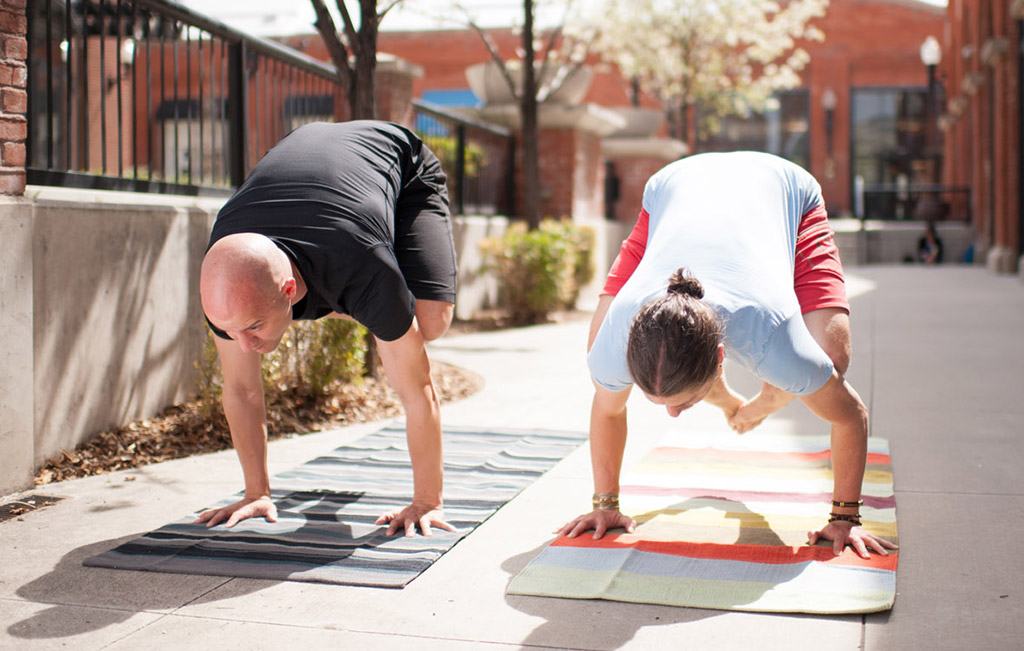
When we think of balancing poses, Vrksasana (Tree Pose) or Hasta Padangusthasana (Standing Big-Toe Pose) often come to mind. But standing on one foot is not the only way to develop the skill of balancing. We can balance on our rear ends, as in Ubhaya Padangusthasana. We can balance on our arms and hands, as in Adho Mukha Vrksasana (Handstand) or Bakasana (Crow Pose). We can even balance on hands and knees, as in Parsva Balasana (Bird Dog Pose).
Balancing poses not only teach the extremely valuable skill of balancing, but they can also help us collect a fragmented mind. They require concentration, so they teach us about concentration.
Arm balances are some of yoga’s more intimidating-looking poses. It’s true that they’re not for everyone. But it’s important to understand that arm strength is not the only factor in determining whether these poses are appropriate for us. Most arm balances also require quite a bit of hip joint mobility. And engaging the core—not just the abdominal muscles, but the organs as well—is essential for practicing arm balances. The instructions below provide a helpful tip for using core support.
The featured pose for this blog, Bakasanana (Crow Pose), is the most accessible arm balance for most people. It strengthens the abdominal muscles, tones the organs back to give frontal support to your spine, promotes hip flexibility, and strengthens your arms and wrists.
How to Practice Bakasana
- Spread a nonskid yoga mat out onto a hard surface such as a wood floor. A thinner mat might be best for this so that you have good contact with the floor.
- Squat on your mat and place a folded yoga blanket—a crash pad—in front of you. If you lose balance and topple forward, it’s important to place something soft where your head might land.
- Place your palms, shoulder-width apart, on the mat in front of you with your fingers spread and your middle fingertips touching your folded blanket.
- Lift your pelvis high, keeping your palms on the floor. Your legs will be bent quite a bit.
- Here’s how to engage your core: Place your knees on the outsides of your shoulders or upper arms and squeeze in on the shoulders so that you feel your abdominal muscles and organs drawing back into your back. Your back should feel somewhat expanded. This step is really important, because it helps you condense your body, which helps your balance tremendously in this pose.
- Simultaneously rock your weight forward and lower your hips slightly, continuing to squeeze your shoulders with your knees. At this point, if you feel comfortable, you can rock slightly forward, coming onto your toes. Feel free to stay here, squeezing in on your shoulders with your feet on the floor.
- If you want to try to balance, from this pose, lift one foot off the floor and check your balance. Then lift the other one—or not.
- Breathe! It’s easy to forget to breathe when you’re really focusing and trying something challenging. Stay for up to five breaths. Sometimes you can only stay for a millisecond. That’s fine too.
- As with all yoga asanas, please don’t push yourself in Bakasana. It is very easy to collapse and fall forward. If you’re not feeling confident to balance, squeezing your shoulders with your knees with your toes on the floor, will still help tone your abdomen and promote hip flexibility.
- Rest in Balasana (Child’s Pose). Then move to Adho Mukha Svanasana (Downward-Facing Dog Pose) to stretch out your abdomen gradually.
Remember that if you never balance in Bakasana, you can still be a good person and a competent yoga practitioner. It’s fun to practice Bakasana, but it is certainly not a staple of practice. Be patient. It took me several years to be able to do it, and I’m still not all that strong in it. If you want to practice it, have fun and take your time. Stabilizing your mind depends more on practicing patience than it does on practicing any particular pose.
Updated article from December 7, 2016.
